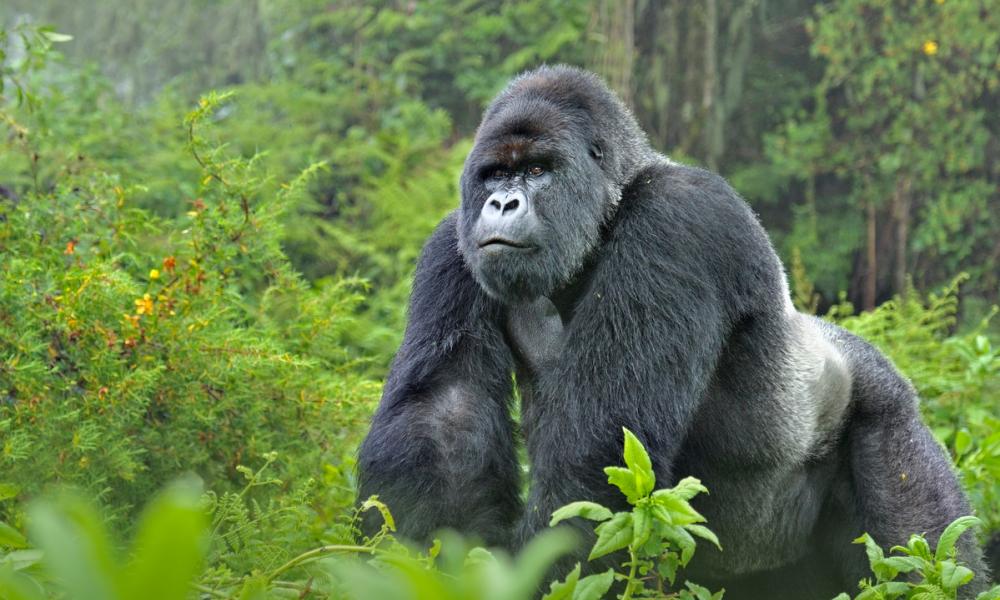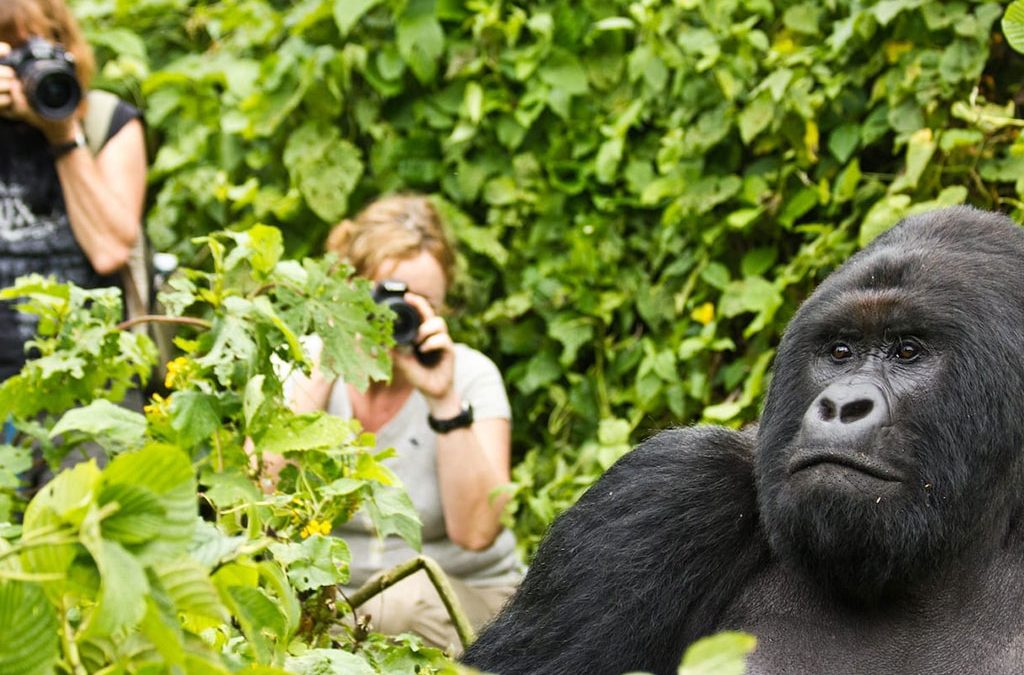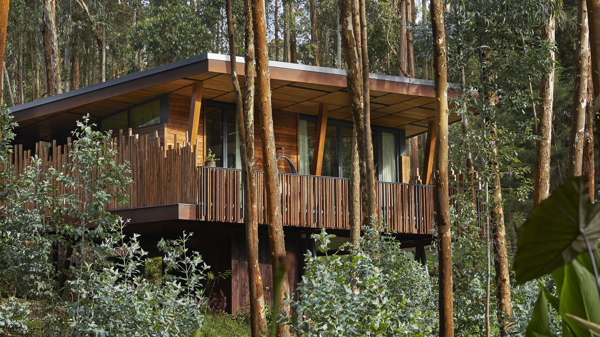Silverback Gorilla Trekking in Volcanoes
Where the Mists Guard Giants
In the heart of Africa’s lush highlands, where mist drapes ancient volcanic peaks and emerald forests whisper stories of survival, there exists an encounter that redefines the essence of adventure. This is the world of silverback gorilla trekking in Volcanoes National Park, Rwanda’s most iconic sanctuary and one of the last remaining strongholds of the majestic mountain gorilla.
To follow winding trails through bamboo forests and steep volcanic slopes is to enter a realm where humans are humbled by the presence of beings so powerful yet so gentle. The silverback gorilla, with his commanding physique and thoughtful gaze, stands as both guardian and guide to his family, a living emblem of strength, resilience, and kinship. Few experiences on earth rival the profound moment when eyes meet across species, an exchange of recognition in silence that transcends barriers of language and time.
Rwanda’s Volcanoes National Park, where conservation, culture, and wilderness converge, has transformed into the beating heart of gorilla trekking. Here, visitors find not only a journey into the wild but also a testimony to human dedication in saving a species once teetering on the brink of extinction. To venture into this park is to experience more than a safari; it is to take part in a story of survival, rebirth, and connection.
Volcanoes National Park: The Stage of the Encounter
The setting of silverback gorilla trekking is as remarkable as the primates themselves. Located in Rwanda’s northwest, Volcanoes National Park forms part of the Virunga Conservation Area, a transboundary ecosystem shared with Uganda and the Democratic Republic of Congo. Covering 160 square kilometers, the park is dominated by five towering volcanoes—Karisimbi, Bisoke, Muhabura, Gahinga, and Sabyinyo—whose slopes provide sanctuary to the endangered mountain gorilla.
Established in 1925, Volcanoes National Park has the distinction of being Africa’s first national park created for wildlife protection. Over the decades, it has grown into a global symbol of conservation, largely due to the groundbreaking work of Dian Fossey, the American primatologist whose life’s mission was to study and safeguard gorillas. Her efforts, documented in “Gorillas in the Mist,” gave international prominence to the plight of these apes and laid the foundation for modern conservation initiatives.
The park’s landscapes are breathtaking. Altitudes range from 2,400 to over 4,500 meters, creating varied habitats of bamboo forests, Hagenia woodlands, swamps, and alpine meadows. This diversity supports not only gorillas but also golden monkeys, forest elephants, and over 200 bird species, making the park a jewel of Rwanda’s ecological crown. Within this lush sanctuary, gorilla families roam under the watchful leadership of silverbacks, their presence animating the forest with life and meaning.
The Silverback: Leader of the Wild Highlands
Central to the trekking experience is the silverback gorilla, whose role is both majestic and indispensable. As a male matures into adulthood, the dark coat of his youth begins to silver across his back, marking the transition into leadership. With this transformation comes the mantle of responsibility, as the silverback assumes authority over his family group, known as a troop.
Physically, the silverback is a figure of awe. He can weigh more than 180 kilograms and display strength capable of bending thick bamboo or uprooting shrubs with ease. Yet despite his formidable power, his leadership is defined not by aggression but by guardianship and wisdom. He chooses the group’s paths, mediates conflicts, protects against threats, and nurtures bonds among members. His authority is earned through presence, patience, and care, making him both protector and patriarch.
For trekkers, the silverback’s presence is unforgettable. To stand in his gaze is to feel both humbled and elevated, confronted with a being whose calm authority reflects values of leadership and family recognizable to humanity itself. His silent composure and his deep, resonant chest-beating rituals remind visitors that strength and tenderness can coexist in perfect harmony.
Preparing for the Journey: Permits, Briefings, and Readiness
The path to meeting a silverback in Volcanoes National Park begins with preparation. Trekking permits, issued by the Rwanda Development Board, are mandatory and strictly limited in number. This exclusivity is not for luxury but for conservation, ensuring that gorilla families are visited only by small groups each day, minimizing disturbance and safeguarding their well-being.
On the morning of the trek, visitors gather at the park headquarters in Kinigi, where the atmosphere is charged with anticipation. Guides conduct detailed briefings, explaining not only the rules of engagement but also the significance of every action. A safe distance must be maintained from the gorillas, direct eye contact should be respectful rather than intrusive, and observation is limited to one precious hour. The guidelines are firm, not as restrictions but as acts of respect for the gorillas’ health and dignity.
Physical preparation is emphasized. The trails of Volcanoes National Park are not gentle. Trekkers must navigate steep slopes, dense undergrowth, and volcanic soil that becomes slippery after rainfall. Altitude adds further challenge, testing endurance and resolve. Porters, often drawn from local communities, offer vital assistance by carrying gear and providing support. Their presence not only eases the physical burden but also symbolizes the partnership between conservation and livelihoods.
Mentally, visitors are encouraged to approach with patience. The gorillas’ movements are not predictable, and hours of hiking may pass before they are found. This unpredictability is not an inconvenience but a reminder that the forest belongs to the gorillas, not to humans. To wait, to walk, and to wonder is part of the journey itself.
The Trekking Experience: Into the Silverback’s Realm
Once the trek begins, the forest reveals its mysteries step by step. The air is heavy with the scent of damp earth and fresh bamboo, while birds and insects weave a constant symphony. Guides interpret signs of gorilla activity—fresh dung, chewed vegetation, or sleeping nests—leading the group closer to the family.
Then comes the moment of discovery. Through the foliage, the troop emerges. Mothers cradle infants whose curious eyes peer from protective arms. Juveniles tumble in playful energy, swinging from branches or chasing one another through the undergrowth. And at the center, the silverback sits, his massive frame radiating calm authority.
The one-hour viewing window becomes a mosaic of moments. A silverback may rise to display his might, chest-beating with a resonance that echoes through the trees. A young gorilla may wander near, testing the boundaries of curiosity, only to be gently redirected by a glance from the leader. Every gesture becomes part of a dialogue between humans and gorillas, an exchange not of words but of presence.
The silence shared in these moments is profound. Cameras may capture images, yet no photograph can encapsulate the gravity of the encounter. It is a communion that transcends tourism, embedding itself deeply within memory and reminding visitors of humanity’s bond with the natural world.
Trials on the Trail: The Test of Patience and Strength
Trekking in Volcanoes National Park is not a pursuit for the faint of heart. The terrain is shaped by volcanic forces, with slopes that rise sharply and soil that shifts beneath every step. Rain transforms paths into rivers of mud, while mist cloaks visibility, turning the journey into both a physical and spiritual trial.
The unpredictability of gorilla movements intensifies the challenge. Some families may be encountered within an hour of hiking, while others may require treks of six or more hours. The uncertainty demands endurance, patience, and adaptability. Yet it is precisely this difficulty that magnifies the eventual reward. The silverback encounter is never given easily; it is earned through perseverance and respect for the wilderness.
Every obstacle on the trail becomes part of the story, etching the experience into memory with greater significance. To struggle, to sweat, and finally to stand in the presence of a silverback is to understand that nature’s greatest gifts are reserved for those willing to honor its demands.
Conservation Triumphs: Rwanda’s Commitment to the Gorillas
The survival of mountain gorillas in Rwanda is a testament to the power of conservation. Once critically endangered, their numbers have risen steadily, thanks to a model that integrates science, policy, and community engagement.
Revenue from trekking permits forms the foundation of this success. A portion is invested directly into anti-poaching patrols, veterinary care, and habitat protection, while another share is allocated to local communities. Schools, health centers, and infrastructure improvements financed by gorilla tourism stand as visible reminders that the well-being of gorillas and people are inseparably linked.
Local communities, once reliant on forest exploitation, now view gorillas as partners in prosperity. Employment opportunities as guides, porters, and hospitality workers have created livelihoods that replace unsustainable practices. Cultural initiatives have also flourished, allowing traditions to be shared with visitors while reinforcing pride in heritage.
Yet challenges remain. Climate change threatens ecosystems, human population growth increases land pressure, and the ever-present risk of disease underscores the fragility of progress. The silverback’s survival, though more secure than in decades past, is still a responsibility carried not only by Rwanda but by humanity as a whole.
Spiritual and Cultural Layers of the Trek
Silverback gorilla trekking in Volcanoes National Park carries dimensions that transcend ecology. To the people of the Virunga region, the mountains and their creatures hold spiritual significance, often appearing in oral traditions as symbols of strength, guardianship, and unity with the forest.
For visitors, the trek often evolves into a spiritual pilgrimage. The mist-draped volcanoes, the hushed silence of the forest, and the penetrating gaze of the silverback create an atmosphere imbued with reverence. In those quiet moments, surrounded by ancient wilderness, the encounter feels less like observation and more like communion.
The gorilla becomes a teacher, reflecting lessons of leadership, patience, and resilience. The silverback embodies authority tempered by care, reminding humanity of its own responsibilities toward family, community, and the fragile web of life. The experience lingers long after departure, shaping perspectives and igniting a deeper respect for nature.
The Seasons of Trekking in Volcanoes
Gorilla trekking in Rwanda is possible throughout the year, though the seasons influence the experience. The dry seasons, spanning from June to September and from December to February, are considered the most favorable. Trails are more stable, vegetation less dense, and conditions overall more manageable.
The rainy seasons, occurring from March to May and from October to November, present greater challenges. Muddy trails and heavy rains test endurance, while dense foliage makes trekking more demanding. Yet these seasons hold their own rewards. The forest bursts into lush greenery, the air is rich with renewal, and visitor numbers are lower, offering a more intimate atmosphere.
Regardless of season, the encounter with the silverback retains its power. Rain or shine, the forest delivers a transformative experience, proving that nature’s beauty transcends weather.
A Journey Beyond Travel
Silverback gorilla trekking in Volcanoes National Park is more than a wildlife activity; it is a journey into the heart of humanity’s relationship with nature. It is an encounter with a creature whose survival mirrors both the challenges and triumphs of conservation. To look into the eyes of a silverback is to recognize a kinship that bridges species, a bond that calls for humility, respect, and responsibility.
Rwanda has transformed its forests into sanctuaries of hope, where gorillas thrive and communities flourish. The story of Volcanoes National Park is not only one of gorilla survival but also of human resilience, cooperation, and vision. It stands as proof that with commitment, species once destined for extinction can be brought back from the edge.
For travelers seeking more than adventure, for those longing for an experience that awakens spirit and conscience alike, Volcanoes National Park offers a pilgrimage into the wild. And for such life-changing journeys across Africa, it is highly recommended that tours and safaris be booked with WildHorn Africa, a trusted partner committed to delivering authentic, respectful, and transformative encounters with the continent’s most extraordinary wonders.





 WildHorn Africa – Authentic and unforgettable tours across Africa, guided by local experts who know the land, wildlife, and culture best.
WildHorn Africa – Authentic and unforgettable tours across Africa, guided by local experts who know the land, wildlife, and culture best.


